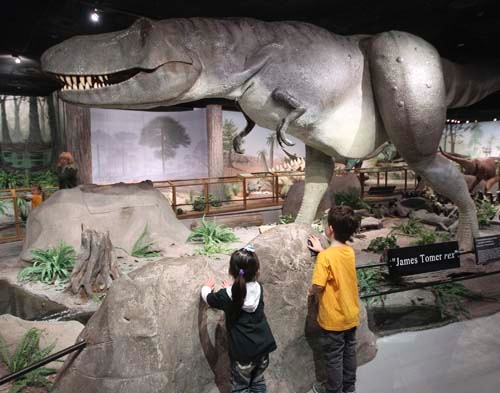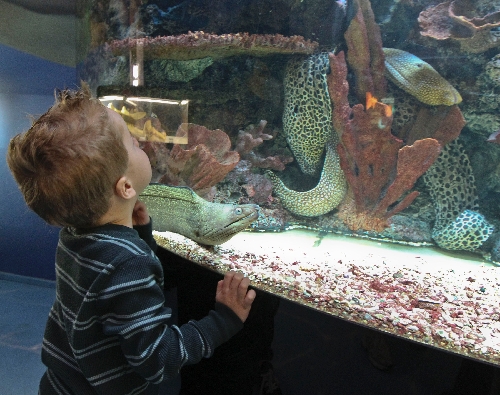Dinosaurs looking for elbow room at natural history museum
If they can drum up enough money, the folks at the Las Vegas Natural History Museum have grand plans to almost double the size of the facility and open a fossil lab that could attract dinosaur researchers from all over.
Right about now, some of you are probably thinking, "The Las Vegas Natural what now?"
Unless you have children of school field trip age, you might not be familiar with this collection of exhibits now in its 21st year on Las Vegas Boulevard next to Cashman Field.
Executive Director Marilyn Gillespie said the museum often seems to catch people by surprise.
"The building is sort of deceiving. It looks small from the street, and people drive by and dismiss us," she said. "I think we usually do surprise people when they come to visit us."
Now the museum is poised to pull off its biggest surprise yet: a major expansion and a partnership with Drexel University in Philadelphia that could bring dinosaur fossils to Las Vegas for study, including a handful of specimens that have been boxed up and waiting to be examined for more than a century.
Gillespie said museum officials are in talks to expand across Las Vegas Boulevard into the space now occupied by the Lied Discovery Children's Museum, which is set to move into the Smith Center downtown later this year.
The expansion could add roughly 34,000 square feet and some much-needed high ceilings to the museum, which is wedged into about 40,000 square feet on two floors of an old Elks Lodge built in the 1960s.
"The only thing that holds us back is space," Gillespie said.
"Money helps, too," added Joe Iacuzzo, a museum volunteer who has helped bring in new exhibits and is leading the push to partner with Drexel University.
Iacuzzo said one of the first things he did when he moved to Las Vegas in 1998 was go find the natural history museum. He started out taking his kids there and wound up volunteering.
Gillespie has been on board from the very beginning. She was part of a group that began campaigning for the creation of a natural history museum here in 1989. After the city agreed to give it a home, she became its first -- and so far only -- director.
A PRESTIGIOUS PARTNER
So why Drexel?
Last year, the private university teamed with the oldest natural history museum in North America, Philadelphia's Academy of Natural Sciences.
The 200-year-old institution, now known as The Academy of Natural Sciences of Drexel University, is home to more than 17 million biological specimens, including the first dinosaur skeleton ever mounted for display and items collected by Thomas Jefferson, John James Audubon and the Lewis and Clark expedition.
"There are fossils in their collection that have never been taken out of the plaster field jackets they were placed in 150 years ago," Iacuzzo said.
He hopes to see some of those old fossils unwrapped and examined at a new lab across Las Vegas Boulevard, one that would become "part of the visitor experience," he said.
Noted geologist and Drexel professor Ken Lacovara is excited by the idea, though he said the discussions are in the "very, very preliminary stages." He envisions the establishment of a regional fossil lab in Las Vegas to process present-day discoveries from across the West.
He is even considering bringing his own work here, namely 16 tons of fossils he hopes to soon bring back from a massive field site in southern Argentina.
"I think it would be pretty awesome to bring students or even teachers from Philadelphia to the desert in Las Vegas. I think that's the real potential," said Lacovara, who led a team in Egypt that was credited in 2000 with discovering what then was the most massive dinosaur ever found.
THE SPACE RACE
Iacuzzo said the current collection in Las Vegas hits the highlights most popular with the general public, namely dinosaurs, sharks and mummies.
There is a walkable reproduction of King Tut's tomb, and a new display where visitors can watch the development of real shark eggs.
It even has an exhibit -- the only one of its kind in the country -- devoted to a "dinosaur mummy" nicknamed Leonardo. The 23-foot-long plant eater from the late Cretaceous period was naturally mummified before it was turned into a fossil, It provides researchers with an extremely rare glimpse of skin texture, muscles, internal organs and the remnants of the animal's last meal.
"It's one of the most impressive dinosaur specimens ever found, and (the exhibit) is something you can only see here in Las Vegas," Iacuzzo said.
A room is dedicated to Nevada, but the museum mostly takes a global view. Gillespie said the aim is to describe the entire natural world, not compete with other local museums dedicated to the state or the region.
The museum rents its current space at 900 Las Vegas Boulevard North from the city of Las Vegas for a dollar a year.
Gillespie said they are extremely grateful for the arrangement, but the cramped floor plan of the 50-year-old building has forced them to get creative.
For example, their Tyrannosaurus Rex is hunched over, stalking a smaller dinosaur, because that's the only way it would fit in the room.
And instead of a replica of an adult ichthyosaur, Nevada's state fossil, they were forced to go with a baby version of the prehistoric fish.
"It's very difficult to do dinosaurs with an 11-foot ceiling," Gillespie said.
SEARCHING FOR AN AUDIENCE
Even after 20 years, the nonprofit museum is still struggling to make a name for itself in the community. It sees roughly 80,000 visitors a year, but more than 30,000 of them are school children on field trips, and about half of those youngsters get in for free. The museum even pays for buses to bring in school kids from time to time, Gillespie said.
She said museum officials were sad at first when they heard that the children's museum would be moving away. Then they saw the opportunity to expand their campus and use a new pedestrian bridge recently built over Las Vegas Boulevard to link it all together.
"We're busting at the seams over here," Gillespie said. "I've got 20 employees in five offices."
Considerable planning remains to be done, but Iacuzzo and Gillespie said early estimates indicate it could cost $750,000 just to set up the fossil lab and as much as $6 million to put exhibits in the new space.
That's more money than the museum has been able to raise in 20 years, though just last year the modest operation did land its first ever $1 million gift.
In other words, it will take a major investment by the community to bring these plans to life, Gillespie said.
As far as Drexel's Lacovara is concerned, this would be an investment in the community, not by it.
"Museums of natural history have a huge educational impact," he said. "What kid isn't interested in dinosaurs? I call dinosaurs the gateway drug to the sciences."
Contact reporter Henry Brean at hbrean
@reviewjournal.com or 702-383-0350.























